Proximity to Community Amenities
The quality of life in a neighborhood is often directly connected to the richness of the associations, organizations, and institutions in that neighborhood. Places like public libraries, civic associations, community centers, schools, public gathering places, and faith-based institutions provide a way for residents to access important resources, connect with one another and build social ties. These organizations and institutions are also the building blocks for creating community capacity – the ability for residents to come together to solve problems and share common interests and concerns.
This map series includes three maps showing proximity to several types of important community organizations and institutions: (1) public libraries, (2) community spaces and gathering places, and (3) faith-based institutions. The fourth map combines the data from the first three maps into a composite heatmap, and the final map shows the composite data aggregated by neighborhood. Data are not available for many types of community spaces and indoor gathering places, but together the maps paint a picture of some of the important civic institutions that make up the richness of community life in neighborhoods across the region.
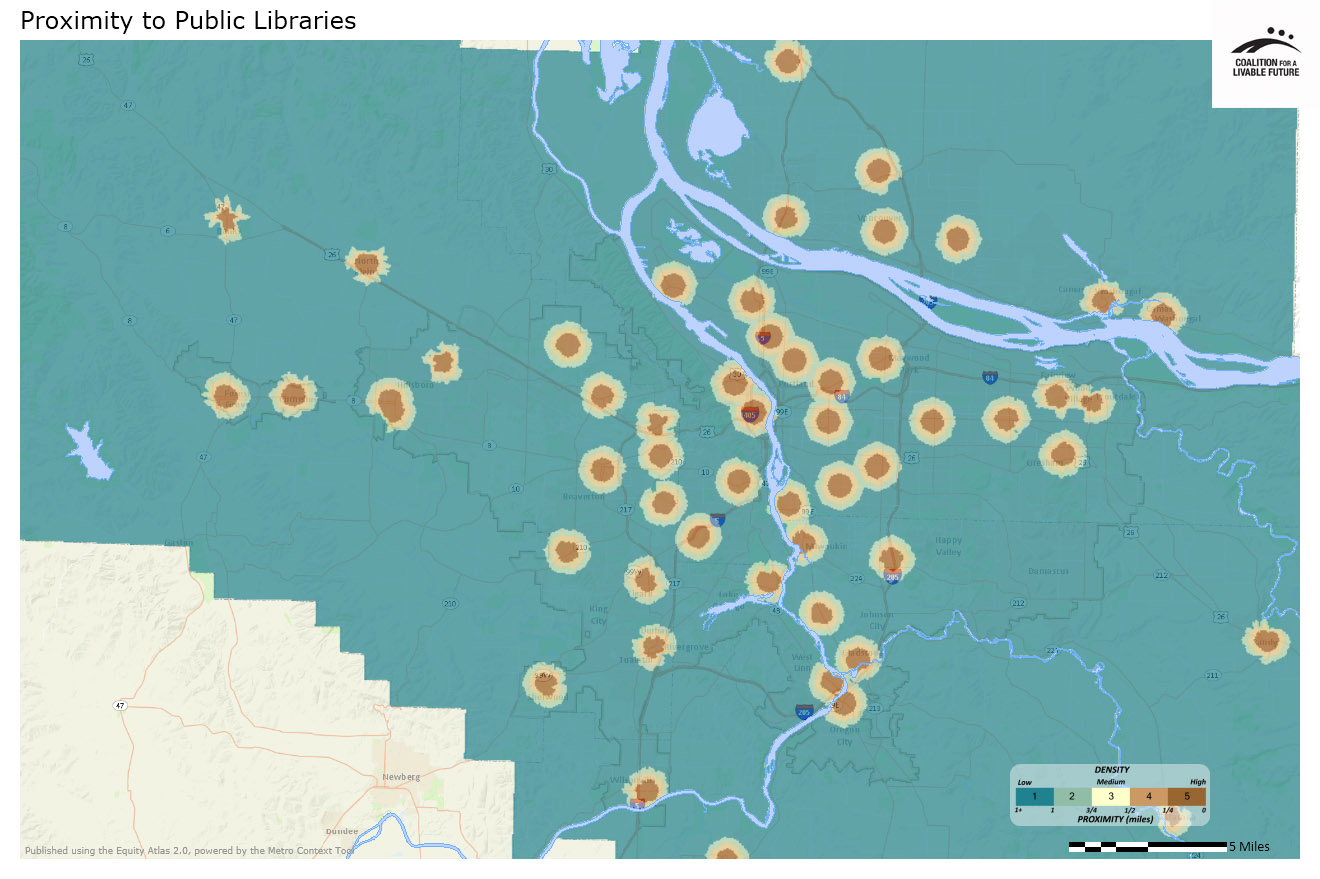
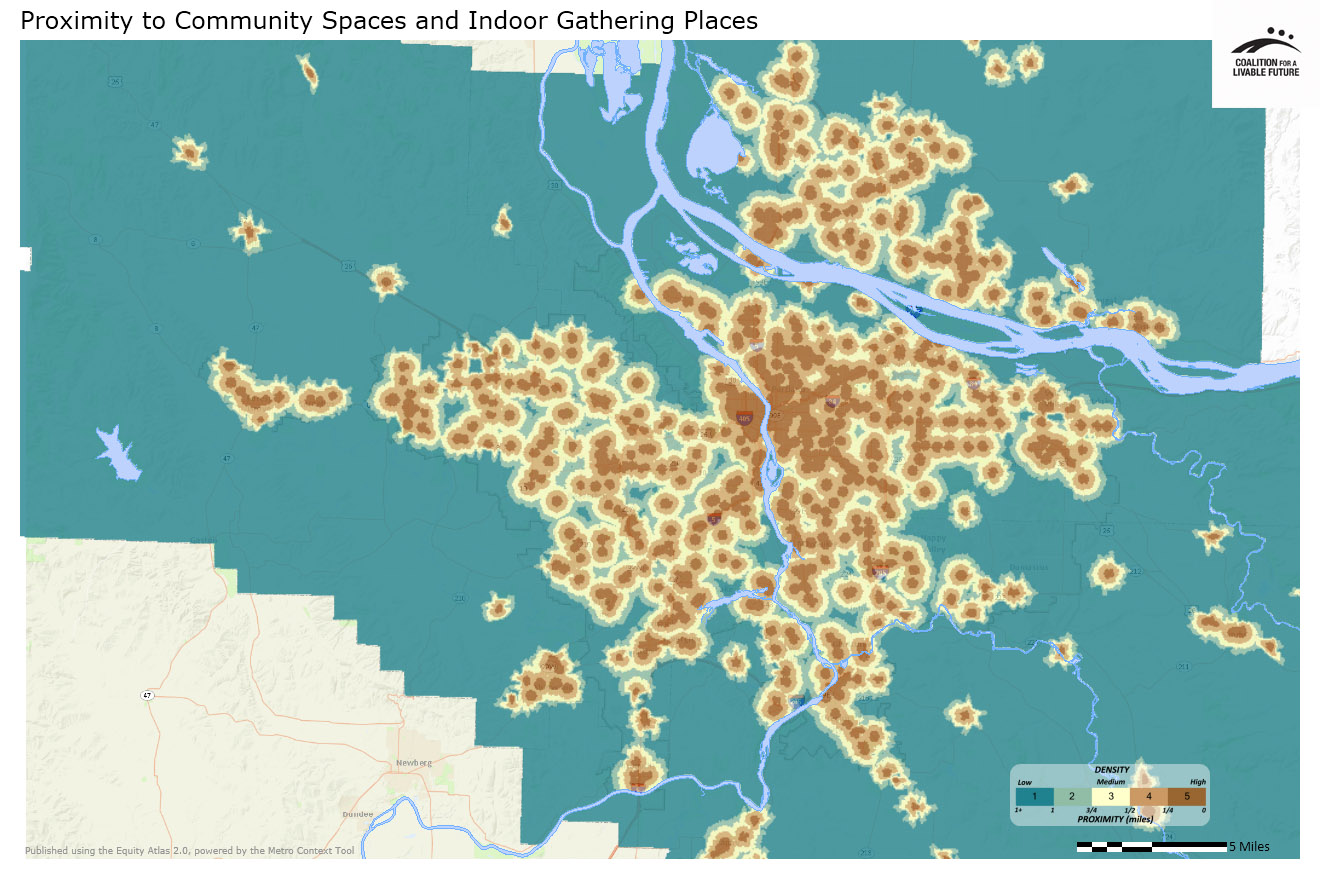
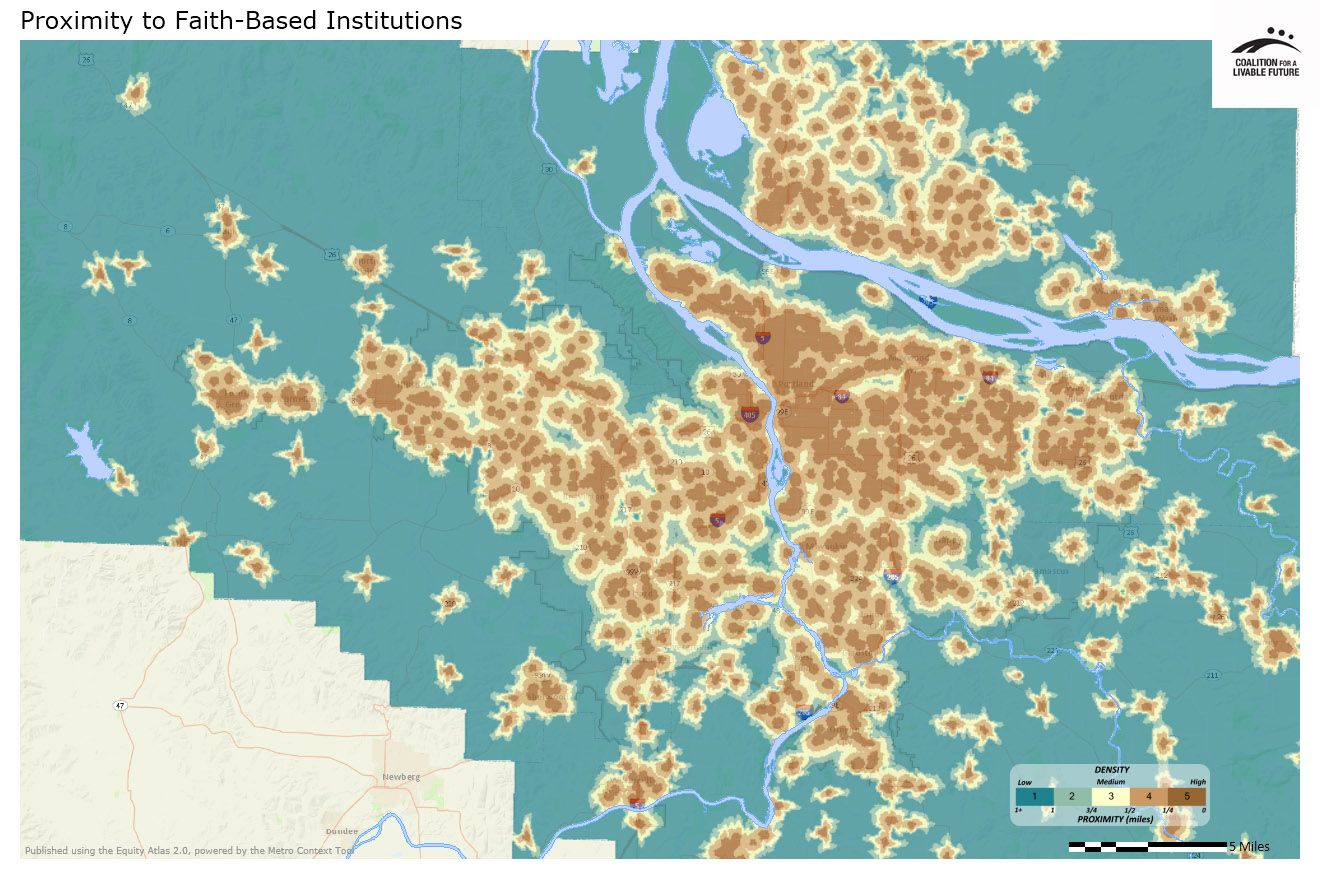
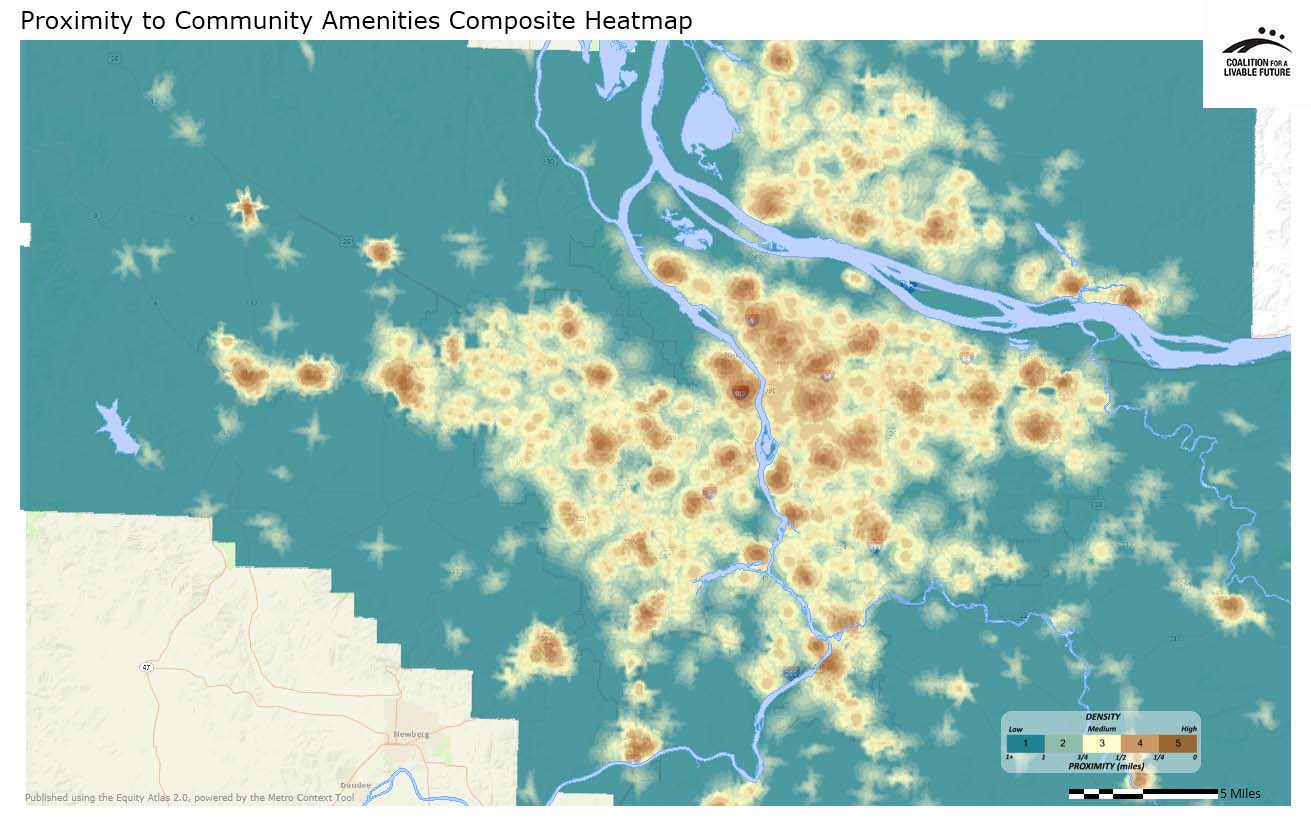
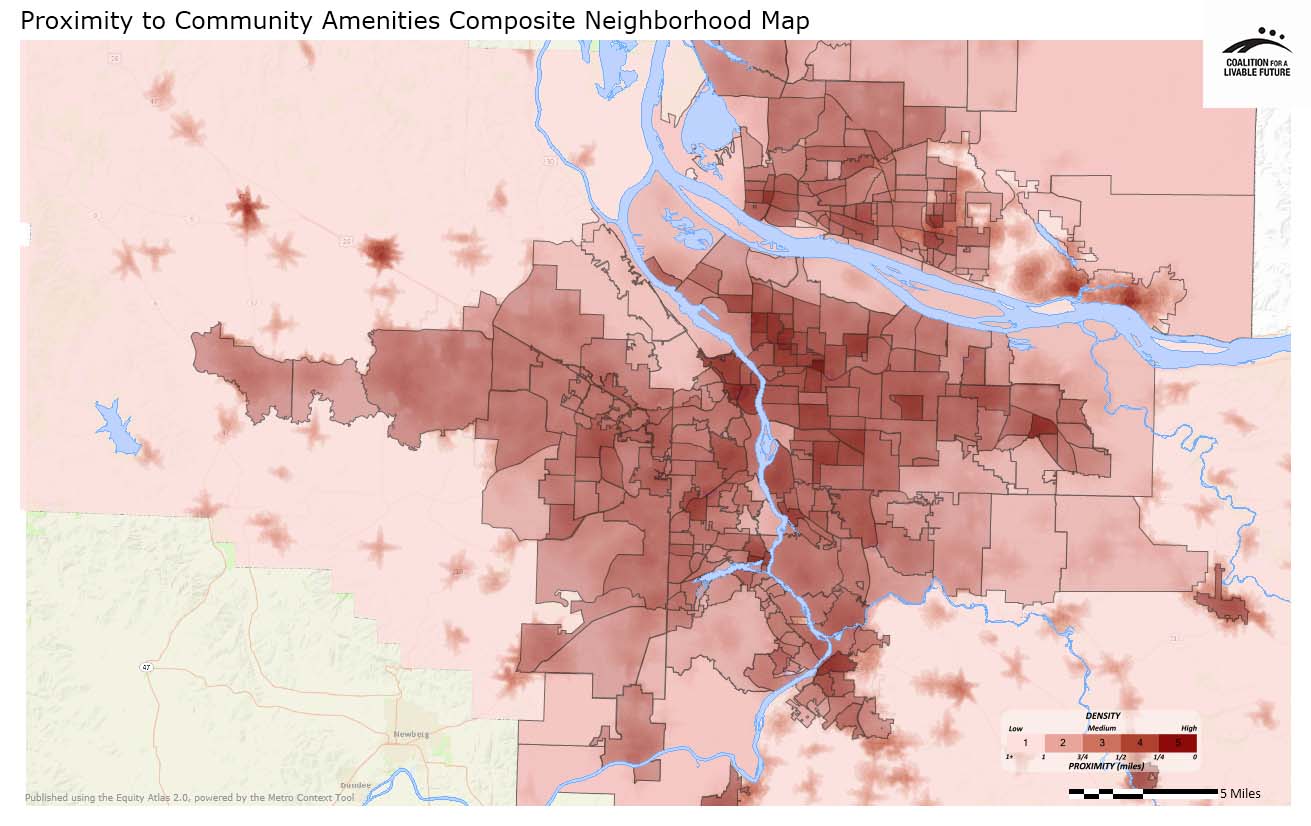
What the Maps Tell Us: Initial Findings
According to the Proximity to Community Amenities Composite Neighborhood Map, neighborhoods with high levels of access to community amenities are located throughout the region, with some clustering near the urban core. The ten neighborhoods in the region with the best access to community amenities are disproportionately located near downtown Portland. This is not surprising, given that amenities such as libraries, gathering places, and faith-based institutions are likely to be more densely clustered in areas with higher population densities. Many older urban neighborhoods also tend to have historic church buildings that continue to house religious congregations.
The Atlas mapping tool can be used to assign a proximity score to every neighborhood in the region based on the average proximity of every block in the neighborhood to community amenities. A score of “5” indicates proximities within ¼ mile, while a score of “1” or below indicates proximities greater than 1 mile. The table below lists the ten neighborhoods in the region with the highest proximity scores and shows how the three components of the “Community Amenities” composite contribute to these neighborhoods’ high scores.
|
Neighborhood |
Location |
Faith-Based Institutions |
Community Spaces and Gathering Places |
Public Libraries |
|---|---|---|---|---|
|
Portland |
5.00 |
5.00 |
4.80 |
|
|
Hollywood |
Portland |
4.96 |
4.90 |
4.51 |
|
Sabin/Irvington |
Portland |
4.46 |
4.89 |
4.57 |
|
Multnomah County Unclaimed #6 (west of Hollywood along I-84) |
Portland |
5.00 |
5.00 |
3.86 |
|
Sabin |
Portland |
4.74 |
4.61 |
4.01 |
|
Humboldt |
Portland |
5.00 |
3.96 |
4.18 |
|
Evergreen |
Lake Oswego |
4.89 |
4.61 |
3.61 |
|
Gresham-City Central |
Gresham |
4.82 |
4.78 |
3.59 |
|
Goose Hollow |
Portland |
4.80 |
4.97 |
3.27 |
|
King |
Portland |
5.00 |
4.88 |
3.17 |
Although the highest scoring neighborhoods are primarily located in Portland, various neighborhoods throughout the region also score high. Examples from among the region’s 50 top scoring neighborhoods include:
|
Neighborhood |
Location |
Faith-Based Institutions |
Community Spaces and Gathering Places |
Public Libraries |
|---|---|---|---|---|
|
Arnada |
Vancouver |
4.99 |
4.97 |
3.00 |
|
Hearthwood |
Vancouver |
4.24 |
4.58 |
3.90 |
|
McLoughlin |
Oregon City |
4.64 |
4.26 |
3.36 |
|
Airport Green |
Vancouver |
4.41 |
3.59 |
3.78 |
|
Foothills |
Lake Oswego |
3.91 |
4.49 |
3.32 |
|
Waverly-Downtown |
Milwaukie |
3.82 |
4.22 |
3.67 |
|
Gresham-Rockwood |
Gresham |
4.34 |
3.75 |
2.70 |
It is notable that the 50 top scoring neighborhoods do not include any neighborhoods in Washington County. Among the top 50 are numerous Portland neighborhoods, several neighborhoods in Vancouver, and a handful of neighborhoods from other locations in Multnomah and Clackamas counties, such as those listed in the table above.
The ten neighborhoods in the region with the poorest access to community amenities tend to be located in unincorporated areas and areas with low population densities in Multnomah, Clark, and Clackamas counties. As with the top 50 list, no Washington County neighborhoods are represented on the bottom 10 list:
|
Neighborhood |
Location |
Faith-Based Institutions |
Community Spaces and Gathering Places |
Public Libraries |
|---|---|---|---|---|
|
Multnomah County Unclaimed #2 (on the Columbia River east of Bridgeton) |
Portland |
0.00 |
0.00 |
0.00 |
|
Hayden Island |
Portland and unincorporated Multnomah County |
0.67 |
1.38 |
0.67 |
|
Columbia Way |
Vancouver |
1.05 |
1.00 |
0.75 |
|
Fruit Valley |
Vancouver and unincorporated Clark County |
0.98 |
1.00 |
0.81 |
|
Multnomah County Unclaimed #14 (north of Damascus) |
Unincorporated Multnomah County |
1.00 |
1.00 |
1.00 |
|
Aurora-Butteville-Barlow |
Canby and unincorporated Clackamas County |
1.20 |
0.97 |
0.96 |
|
Enterprise/Paradise Point |
Unincorporated Clark County |
1.18 |
0.99 |
0.98 |
|
West Hazel Dell |
Unincorporated Clark County |
1.56 |
1.12 |
0.47 |
|
Proebstel |
Unincorporated Clark County |
1.09 |
1.06 |
1.00 |
|
Washougal River |
Camas, Washougal, and unincorporated Clark County |
1.18 |
1.03 |
1.00 |
The Atlas online mapping tool can be used to generate similar data for every neighborhood in the region. These data can provide useful insights to inform efforts to strengthen community amenities, and to target investments in libraries and other community infrastructure to the neighborhoods that need those investments the most. Of course, in order to assess whether neighborhoods that score poorly on this composite indicator are high priorities for targeted investments, we would need to combine our analysis of access to community amenities with an analysis of population density, demographics, and other factors. The Atlas mapping tool provides the data necessary for this more detailed investigation.
About the Maps
Proximity to Public Libraries
This map shows proximity to the region’s public libraries.
Data Source: Metro RLIS (2012)
Proximity to Community Spaces and Indoor Gathering Places
This map shows proximity to a variety of community spaces and indoor gathering places. It includes community centers, schools, coffee shops, grange associations and organizations classified as “civic and social organizations” by North American Industry Classification System codes. Comprehensive data are not available for all the community spaces and indoor gathering places in the region; this map is based on those for which mappable data are available.
Data Source: ESRI Business Analyst (2010), Metro RLIS (2012)
Proximity to Faith-Based Institutions
This map shows proximity to organizations classified by North American Industry Classification System codes as “establishments primarily engaged in operating religious organizations, such as churches, religious temples, and monasteries, and/or establishments primarily engaged in administering an organized religion or promoting religious activities.” It does not include informal faith-based groups that are not registered as formal organizations.
Data Source: ESRI Business Analyst (2010)
Proximity to Community Amenities Composite Heatmap
This map combines the data from the Proximity to Public Libraries, Proximity to Community Spaces and Indoor Gathering Places, and Proximity to Faith-Based Institutions maps to create a composite heatmap. The proximity scores from each of the individual maps are combined into a composite score that is the basis for the composite heatmap.
Data Source: ESRI Business Analyst (2010), Metro RLIS (2012)
Proximity to Community Amenities Composite Neighborhood Map
This map uses the same underlying data as the Proximity to Community Amenities Composite Heatmap, but instead of showing the data as a heatmap, it aggregates the data by neighborhood. The darker the neighborhood, the greater the proximity to community amenities.
Data Source: ESRI Business Analyst (2010), Metro RLIS (2012)
*Some neighborhood boundaries overlap. The Atlas refers to the areas within the overlapping boundaries by the names of both neighborhoods.
|
This document was downloaded from the Map Series library of the Coalition for a Livable Future’s Regional Equity Atlas 2.0 website. The Regional Equity Atlas is a research and education project to promote widespread opportunity for a stronger, healthier, and more sustainable Portland-Vancouver metropolitan region. For more information, visit www.equityatlas.org. |
